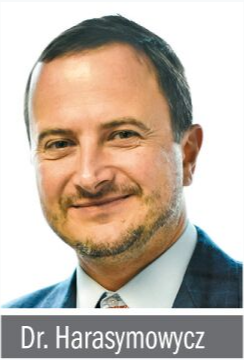Primary lens extraction rivals iridotomy in primary angle closure
Approach more cost-effective, considered as option for first-line therapy, suggests surgeon


Clear lens extraction is not necessarily right for every patient, but surgeons should have this discussion with their primary angle closure (PAC) or primary angle-closure glaucoma (PACG) patients.
Reviewed by Paul J. Harasymowycz, MD
A three-year follow-up to the landmark EAGLE study in patients with primary angle closure confirms initial findings that primary lens extraction produces better clinical outcomes and better quality of life compared with standard care with laser peripheral iridotomy plus topical medical treatment.
Clear lens extraction is more cost-effective than primary iridotomy and should be considered as an option for first-line treatment, said Paul J. Harasymowycz, MD.
“Based on the evidence, one should not jump straight to iridotomy when a patient presents with narrow angles,” said Dr. Harasymowycz, chief of glaucoma, University of Montreal, and director, Montreal Glaucoma Institute.
“Clear lens extraction is not necessarily right for every patient, but ophthalmologists should be having this discussion about clear lens extraction with their primary angle closure (PAC) or primary angle-closure glaucoma (PACG) patients.”
EAGLE follow-up
Dr. Haraymowycz discussed the three-year, follow-up analysis of EAGLE patients. The initial study, published in The Lancet in 2016, concluded that clear lens extraction was both more effective than primary laser iridotomy and more cost effective. Follow-up analysis focusing on long-term visual acuity was published in The British Journal of Ophthalmology in 2018.
The findings that favor clear lens extraction follow World Glaucoma Association angleclosure staging criteria that divide angle closure into three categories:
- Primary angle closure suspect, (PACS), with 180° of appositional closure;
- Primary angle closure (PAC) with peripheral anterior synechiae (PAS) or high IOP shows trabecular meshwork dysfunction; and
- Primary angle-closure glaucoma (PACG), shows signs of structural of functional glaucoma damage.
The EAGLE trial randomly assigned 419 PAC and PACG patients with an IOP of 30 mm Hg or higher to either clear lens extraction or standard care. Of the group, 155 patients had PAC and 263 had PACG. None of the patients had existing cataracts and all were age 50 and older.
Quality of life was assessed using three scales: National Eye Institute 25-Item Visual Function Questionnaire, the European Quality of Life-5 Dimensions Questionnaire, and the Glaucoma Utility Index. After treatment, clear lens extraction patients were on a mean of 0.4 medications versus 1.3 medications for iridotomy patients (p < 0.0001) and had an IOP of 16.6 mm Hg versus 17.9 mm Hg (p < 0.004).
Only one clear lens extraction required additional surgery, whereas 24 iridotomy patients need additional treatment. Patient-reported quality of life was significantly higher for the clear lens extraction group, and the incremental cost effectiveness ratio was £14,284, about $18,300 at current exchange rates, in favor of clear lens extraction.
Study authors noted: “Laser peripheral iridotomy as the initial treatment for angle-closure glaucoma should be reconsidered. This study provides robust evidence that initial clear lens extraction is associated with better clinical and patient reported outcomes and that this approach is likely to be cost effective in a publicly funded health system.”
Three years later, corrected distance visual acuity for the clear lens extraction group was virtually unchanged, 79.9 letters compared with 77.9 letters at baseline. Slightly over half of eyes, 59.9%, were within 0.5 D of predicted refraction and 85% of eyes were within 1 D.
“The major conclusion is the clear lens extraction is beneficial to both the patient and the healthcare system,” Dr. Haraymowycz said. “The vast majority of patients that have a narrow angle are already presbyopic and can benefit from the different types of multifocal or extended-depth-of-focus IOLs that are available, depending on where they live or if glaucoma damage is present. But the three-year results tell us not to overpromise that patients will not need glasses. Only 85% of patients were within 1 D of emetropia, and a discussion of effective lens position is crucial in this patient demographic.”
Disclosures:

Paul J. Haraymowycz, MD
P: 514/781-0483 E: pavloh@igmtl.com
This article was adapted from Dr. Haraymowycz’s presentation during Glaucoma Subspecialty Day at the 2018 meeting of the American Academy of Ophthalmology. He is a speaker/consultant with Aerie Pharmaceuticals, Alcon Laboratories, Allergan, Bausch + Lomb, Glaukos, Ivantis, Johnson & Johnson Vision, and Novartis.
